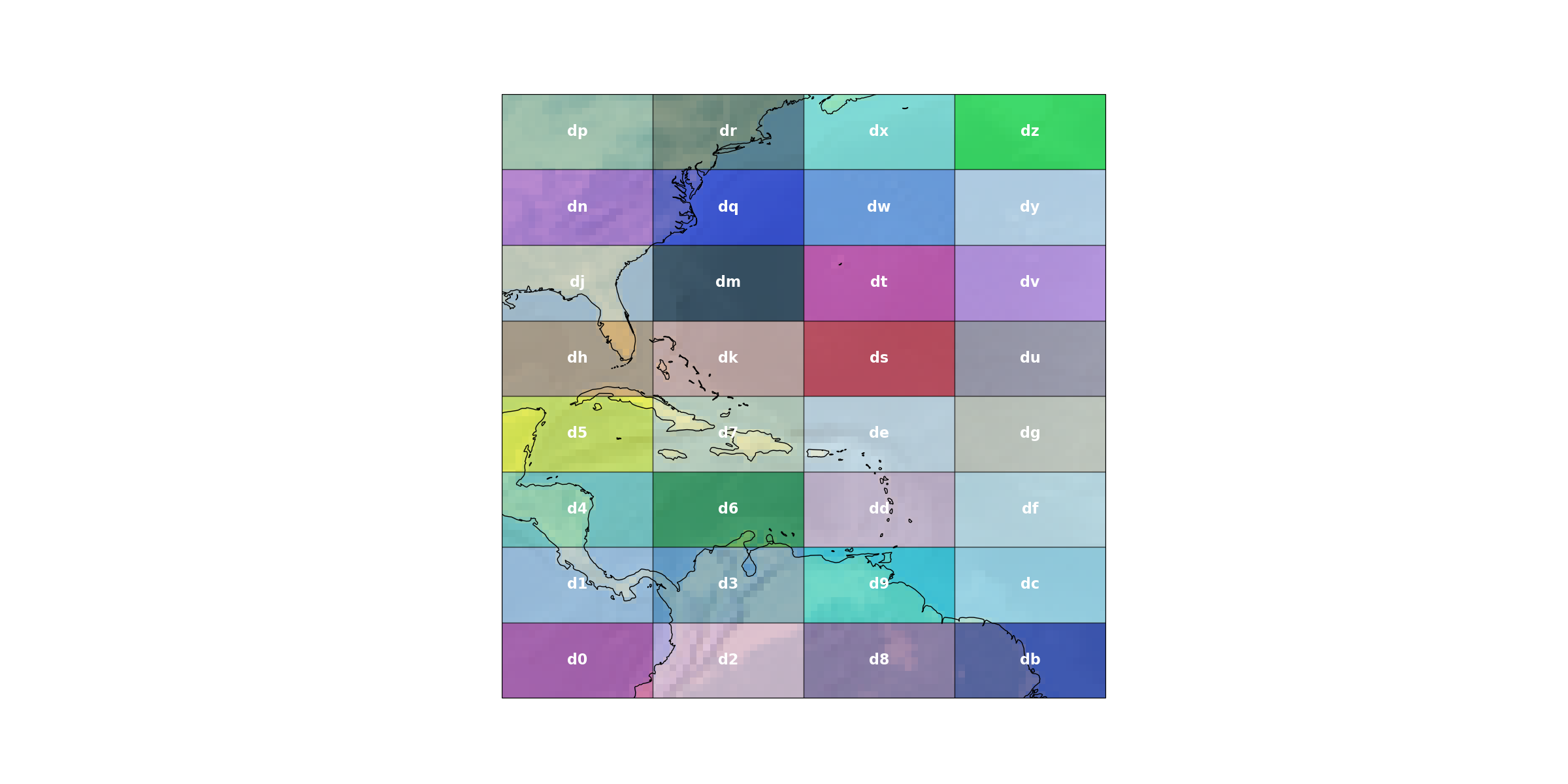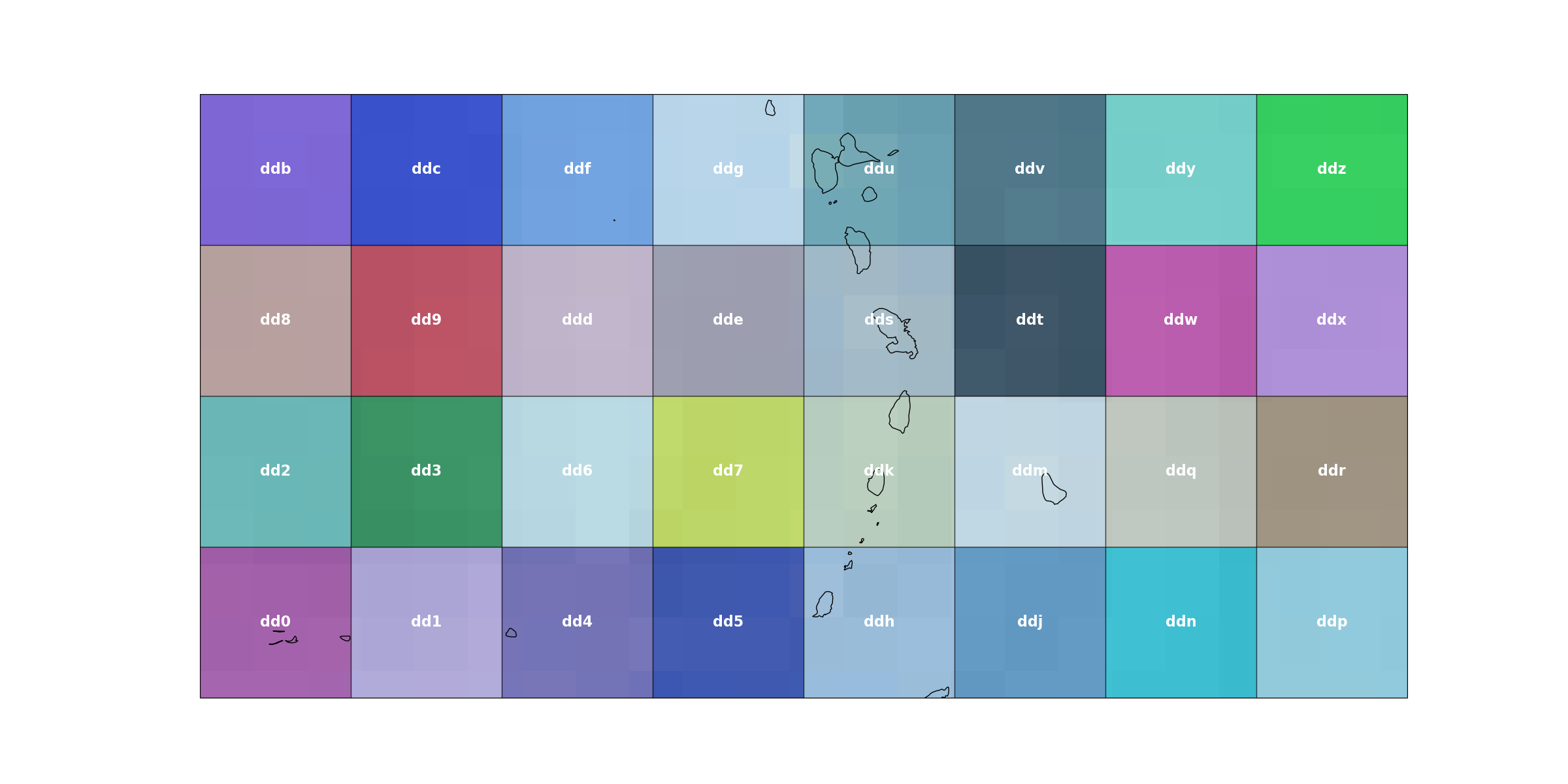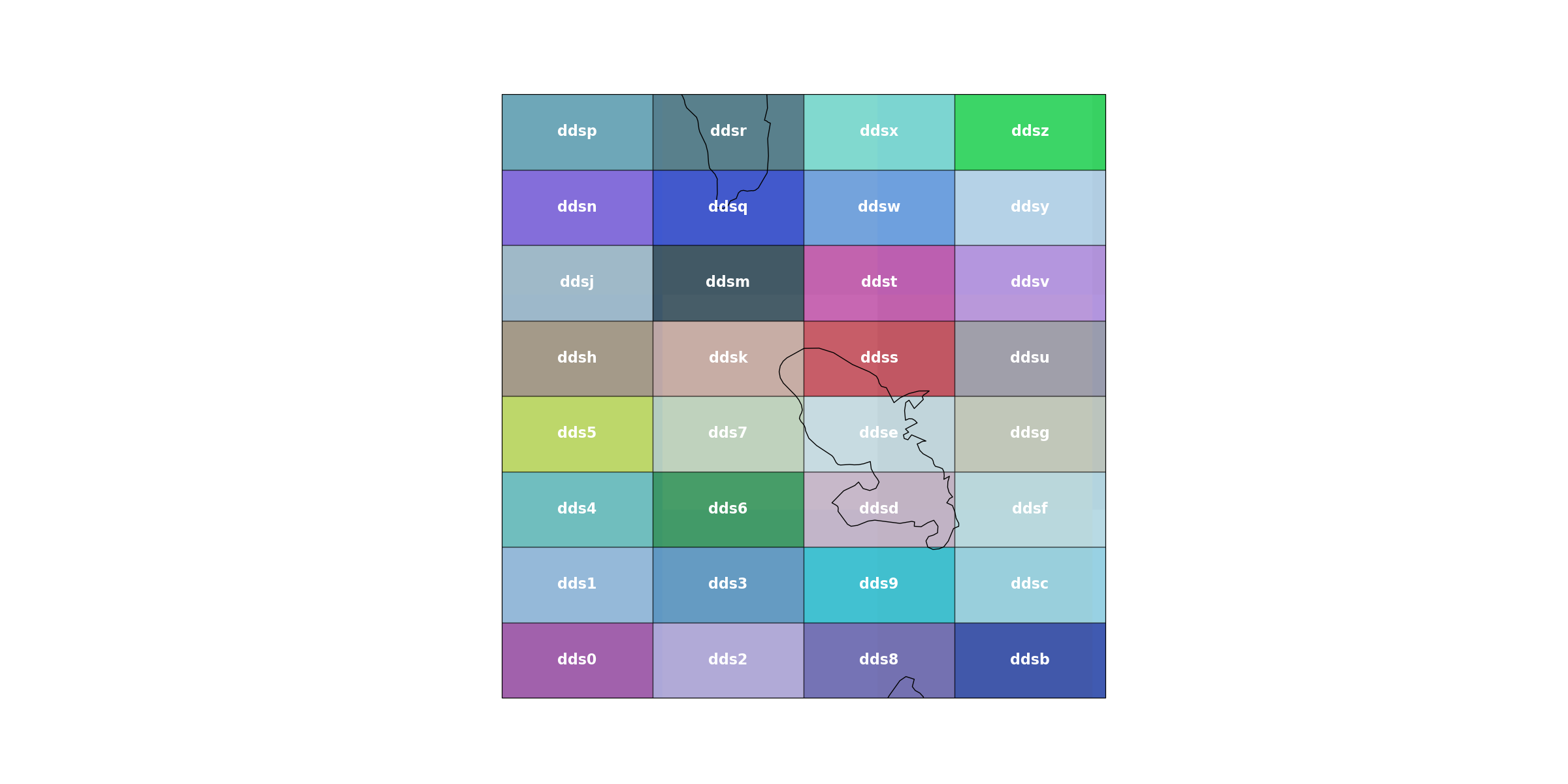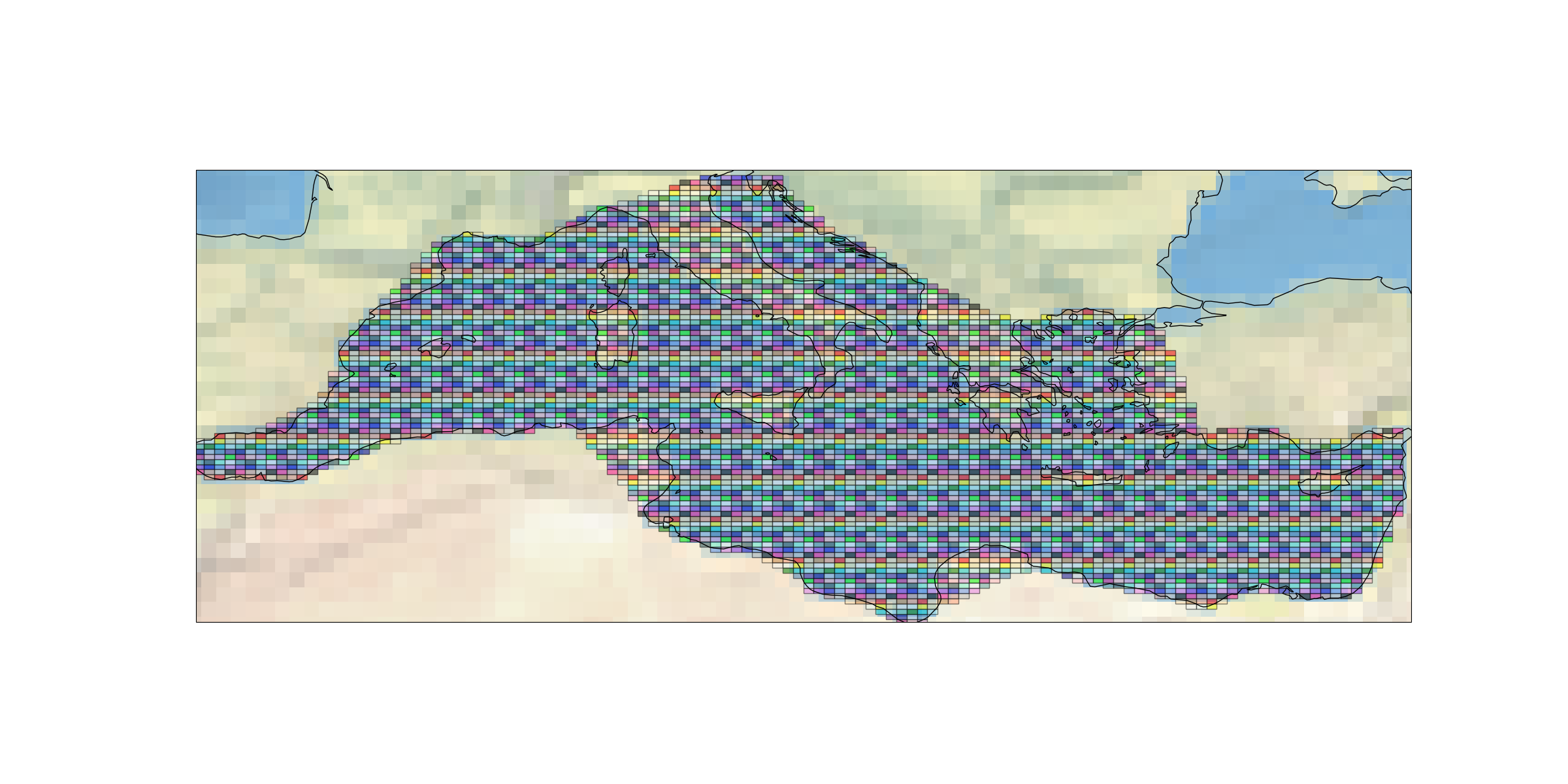Note
Go to the end to download the full example code or to run this example in your browser via Binder
Geohash#
Geohashing is a geocoding method used to encode geographic coordinates (latitude and longitude) into a short string of digits and letters delineating an area on a map, which is called a cell, with varying resolutions. The more characters in the string, the more precise the location.
Geohash Grid#
import timeit
import cartopy.crs
import matplotlib.colors
import matplotlib.patches
import matplotlib.pyplot
import numpy
import pandas
#
import pyinterp
Writing a visualization routine for GeoHash grids.
def _sort_colors(colors):
"""Sort colors by hue, saturation, value and name in descending order."""
by_hsv = sorted(
(tuple(matplotlib.colors.rgb_to_hsv(matplotlib.colors.to_rgb(color))),
name) for name, color in colors.items())
return [name for hsv, name in reversed(by_hsv)]
def _plot_box(ax, code, color, caption=True):
"""Plot a GeoHash bounding box."""
box = pyinterp.GeoHash.from_string(code.decode()).bounding_box()
x0 = box.min_corner.lon
x1 = box.max_corner.lon
y0 = box.min_corner.lat
y1 = box.max_corner.lat
dx = x1 - x0
dy = y1 - y0
box = matplotlib.patches.Rectangle((x0, y0),
dx,
dy,
alpha=0.5,
color=color,
ec='black',
lw=1,
transform=cartopy.crs.PlateCarree())
ax.add_artist(box)
if not caption:
return
rx, ry = box.get_xy()
cx = rx + box.get_width() * 0.5
cy = ry + box.get_height() * 0.5
ax.annotate(code.decode(), (cx, cy),
color='w',
weight='bold',
fontsize=16,
ha='center',
va='center')
def plot_geohash_grid(precision,
polygon=None,
caption=True,
color_list=None,
inc=7):
"""Plot geohash bounding boxes."""
color_list = color_list or matplotlib.colors.CSS4_COLORS
fig = matplotlib.pyplot.figure(figsize=(24, 12))
ax = fig.add_subplot(1, 1, 1, projection=cartopy.crs.PlateCarree())
if polygon is not None:
box = polygon.envelope() if isinstance(
polygon, pyinterp.geodetic.Polygon) else polygon
ax.set_extent(
[
box.min_corner.lon,
box.max_corner.lon,
box.min_corner.lat,
box.max_corner.lat,
],
crs=cartopy.crs.PlateCarree(),
)
else:
box = None
colors = _sort_colors(color_list)
ic = 0
codes = pyinterp.geohash.bounding_boxes(polygon, precision=precision)
color_codes = {codes[0][0]: colors[ic]}
for item in codes:
prefix = item[precision - 1]
if prefix not in color_codes:
ic += inc
color_codes[prefix] = colors[ic % len(colors)]
_plot_box(ax, item, color_codes[prefix], caption)
ax.stock_img()
ax.coastlines()
ax.grid()
Bounds of geohash with a precision of 1 character.
plot_geohash_grid(1)

Bounds of the geohash d with a precision of two characters.
plot_geohash_grid(2, polygon=pyinterp.GeoHash.from_string('d').bounding_box())

Bounds of the geohash dd with a precision of three characters.
plot_geohash_grid(3, polygon=pyinterp.GeoHash.from_string('dd').bounding_box())

Bounds of the geohash dds with a precision of four characters.
plot_geohash_grid(4,
polygon=pyinterp.GeoHash.from_string('dds').bounding_box())

The GeoHash class allows encoding a coordinate
into a GeoHash code in order to examine its properties: precision, number of
bits, code, coordinates of the grid cell, etc.
code = ds00)
precision = 4
number of bits = 20
lon/lat = (-67.3242, 22.5879)
You can also use this class to get the neighboring GeoHash codes of this instance.
[str(item) for item in code.neighbors()]
# On the other hand, when you want to encode a large volume of data, you should
# use functions that work on numpy arrays.
['ds01', 'ds03', 'ds02', 'debr', 'debp', 'd7zz', 'dkpb', 'dkpc']
Encoding coordinates#
Generation of dummy data
SIZE = 1000000
lon = numpy.random.uniform(-180, 180, SIZE)
lat = numpy.random.uniform(-80, 80, SIZE)
measures = numpy.random.random_sample(SIZE)
Encoding the data
array([b'8b77', b'qmc1', b'w8z4', ..., b'gerj', b'jfjx', b'k2uq'],
dtype='|S4')
This algorithm is very fast, which makes it possible to process a lot of data quickly.
timeit.timeit('pyinterp.geohash.encode(lon, lat)',
number=50,
globals=dict(pyinterp=pyinterp, lon=lon, lat=lat)) / 50
0.03364990139998554
The inverse operation is also possible.
You can also use the pyinterp.geohash.transform() to transform
coordinates from one précision to another.
array([b'0', b'1', b'2', b'3', b'4', b'5', b'6', b'7', b'8', b'9', b'b',
b'c', b'd', b'e', b'f', b'g', b'h', b'j', b'k', b'm', b'n', b'p',
b'q', b'r', b's', b't', b'u', b'v', b'w', b'x', b'y', b'z'],
dtype='|S1')
array([b'000', b'001', b'004', ..., b'zzv', b'zzy', b'zzz'], dtype='|S3')
The pyinterp.geohash.bounding_boxes() function allows calculating the
GeoHash codes contained in a box or a polygon. This function allows,
for example, to obtain all the GeoHash codes present on the Mediterranean.
MEDITERRANEAN_SEA = [(-1.43504, 35.38124), (-1.68901, 35.18381),
(-1.93947, 35.18664), (-2.18994, 35.18945),
(-2.44041, 35.19223), (-2.69089, 35.19498),
(-3.19185, 35.20043), (-3.44234, 35.20312),
(-4.19382, 35.21103), (-4.44432, 35.21363),
(-4.69483, 35.21619), (-4.94221, 35.42047),
(-5.18954, 35.62438), (-5.18619, 35.82515),
(-5.18272, 36.02538), (-5.17911, 36.22509),
(-4.92467, 36.42114), (-4.41929, 36.61311),
(-4.16856, 36.60978), (-3.91785, 36.60641),
(-3.66714, 36.60302), (-3.41643, 36.59959),
(-1.64252, 37.35734), (-0.61682, 38.11193),
(-0.05974, 39.61617), (-0.05188, 39.80296),
(0.47608, 40.34624), (1.0068, 40.88237),
(1.26823, 41.05687), (3.17405, 43.12814),
(3.95946, 43.44167), (4.21176, 43.4303),
(4.46402, 43.41885), (5.4578, 43.20103),
(7.00043, 43.46998), (7.2684, 43.62615),
(8.32692, 44.07445), (8.59664, 44.22593),
(8.86679, 44.37629), (9.11878, 44.36187),
(12.30323, 45.45208), (12.82897, 45.57254),
(13.35502, 45.69103), (13.60653, 45.6726),
(14.56628, 45.29165), (14.77339, 44.96545),
(16.35039, 43.4468), (16.83351, 43.25904),
(17.31681, 43.07169), (18.26742, 42.54036),
(18.50146, 42.36803), (18.73581, 42.19562),
(19.45557, 41.83742), (22.59567, 40.39801),
(23.86967, 40.66103), (24.38198, 40.79528),
(25.14395, 40.91539), (25.39346, 40.90312),
(25.87922, 40.72341), (27.3756, 40.65146),
(27.3629, 40.4972), (27.35049, 40.34214),
(28.89327, 36.67855), (30.6478, 36.80647),
(30.89745, 36.80017), (31.14709, 36.79388),
(31.63983, 36.61137), (32.1328, 36.42873),
(34.38535, 36.54538), (34.64117, 36.70704),
(34.89068, 36.70094), (35.89499, 36.84229),
(36.14443, 36.83607), (36.13812, 36.67067),
(35.84461, 35.31519), (35.83989, 35.14037),
(35.83535, 34.96453), (35.83096, 34.78764),
(35.82673, 34.60973), (35.82266, 34.43077),
(35.56521, 34.07323), (35.30493, 33.52656),
(35.04582, 32.96983), (34.78535, 32.21131),
(34.53086, 31.82665), (34.27678, 31.43758),
(34.02492, 31.24227), (33.77499, 31.24401),
(33.52506, 31.24576), (33.27513, 31.24751),
(33.02519, 31.24927), (32.77526, 31.25102),
(32.52532, 31.25279), (32.27538, 31.25455),
(30.52777, 31.46553), (29.27227, 30.87518),
(29.0223, 30.87679), (28.27422, 31.08288),
(27.52624, 31.28865), (26.5284, 31.49606),
(25.53067, 31.70343), (25.28069, 31.70546),
(24.03548, 32.11364), (23.28805, 32.31846),
(20.02259, 30.93524), (19.77083, 30.7316),
(19.51917, 30.52699), (19.26761, 30.32143),
(19.01759, 30.32277), (18.51909, 30.5327),
(17.77237, 30.94967), (17.0241, 31.15993),
(16.02586, 31.37173), (15.77581, 31.37348),
(15.52992, 31.78362), (13.79181, 32.80886),
(12.7914, 32.81862), (12.54129, 32.82104),
(12.04387, 33.02684), (11.54655, 33.23236),
(10.30532, 33.84446), (10.05858, 34.04584),
(10.06218, 34.24361), (7.87667, 36.9875),
(7.12516, 37.00275), (6.87464, 37.00779),
(5.86671, 36.83664), (5.61618, 36.84139),
(5.36563, 36.84612), (5.11508, 36.85081),
(4.86453, 36.85549), (3.61163, 36.87846),
(2.60396, 36.70273), (2.35336, 36.70699),
(1.34599, 36.52884), (0.07965, 35.95831),
(-0.67601, 35.77038), (-1.43504, 35.38124)]
polygon = pyinterp.geodetic.Polygon(
[pyinterp.geodetic.Point(lon, lat) for lon, lat in MEDITERRANEAN_SEA])

Density calculation#
df = pandas.DataFrame(
dict(lon=lon,
lat=lat,
measures=measures,
geohash=pyinterp.geohash.encode(lon, lat, precision=3)))
df.set_index('geohash', inplace=True)
df = df.groupby('geohash').count()['measures'].rename('count').to_frame()
df['density'] = df['count'] / (
pyinterp.geohash.area(df.index.values.astype('S')) / 1e6)
array = pyinterp.geohash.to_xarray(df.index.values.astype('S'), df.density)
array = array.where(array != 0, numpy.nan)
fig = matplotlib.pyplot.figure()
ax = fig.add_subplot(111)
_ = array.plot(ax=ax)

Total running time of the script: (0 minutes 8.757 seconds)